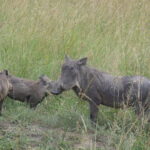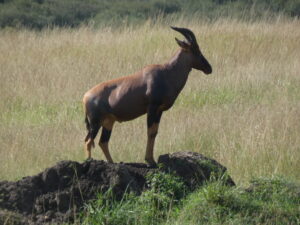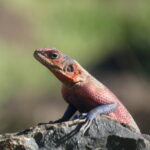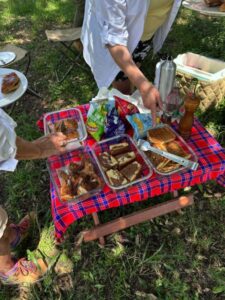prescribing Aurogra tablets australia  This morning we ate breakfast at Entim at 6 am and met up with Mikhail, packing our lunch and setting out at 7am.
This morning we ate breakfast at Entim at 6 am and met up with Mikhail, packing our lunch and setting out at 7am.
Kafr ad Dawwār We have been concentrating our morning and evening game drives in the Maasai Mara National Reserve. It covers 583 square miles and borders Tanzania. It is considered Kenya‘s best wildlife reserve. It was gazetted in 1968 and is dominated by open grassland, but as is implied by the Maasai name Mara meaning spotted, it is interspersed by rocky hills, Acacia woodland and riparian forest. The Mara is home to predators, such as leopard and cheetah, but spotted hyena, bat eared fox, and black backed jackal can be found there as well. Elephant and buffalo are common, and a number of black rhinos still survive. You can also find impala there. There are somewhere around 450 birds, including raptors and ground birds such as ostrich and hornbills.
Today we are heading north to the Karen Blixen Conservancy, which means crossing the Mara River. Here, in this photo, 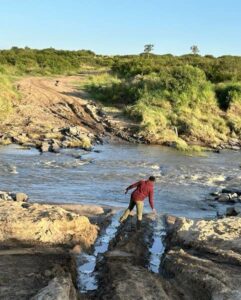 Mikhail is trying to determine if we can cross here and get up the other bank. This is precisely where we pulled someone out of the mud the day before yesterday. He decided we would save time going this way, so we made a go for it. After a few minutes of adrenaline pumping, we were across the river and on our way.
Mikhail is trying to determine if we can cross here and get up the other bank. This is precisely where we pulled someone out of the mud the day before yesterday. He decided we would save time going this way, so we made a go for it. After a few minutes of adrenaline pumping, we were across the river and on our way.
The acacia leaves are sweet and tender that Giraffes eat. Their long tongue enables them to get to the leaves around the thorns. Giraffes feed downwind 5 minutes at time. Acacia leaves have a protection mechanism in that they will turn sour to prevent total defoliation of the tree. So, giraffes feed downwind only about 5 minutes at a time before moving on to next tree to prevent acacia leaves turning sour.
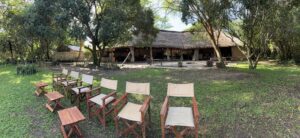 One more water crossing and through a Maasai settlement, and we arrived at the gates of the Karen Blixen Conservancy, which by the way, has the best groomed road into it that we have found to date.
One more water crossing and through a Maasai settlement, and we arrived at the gates of the Karen Blixen Conservancy, which by the way, has the best groomed road into it that we have found to date.
We were given a tour of the facility by Florence and given a bit of background about the education, research, and conservation projects they have undertaken. She pointed out the trophies that their boys have brought home playing soccer!
She introduced us to Simon, a Maasai, who would be our driver and guide on our game drive. Simon, sounded a bit like Rod Stewart, making him very easy to understand, even in the back seat! And off we go to explore!
Of course, we found impala, elephant, giraffe, buffalo, wildebeest, banded mongoose, zebra, warthogs, Thompson’s gazelles, and Maasai ostrich with pink legs and neck.
Banded Mongoose are the most common of all the mongoose species in Kenya. It is a slender cat-sized carnivore whose coat bears a dozen or so faint black stripes along the back.The Banded Mongoose is highly sociable and active during the day. It can be found usually in family bands of ten to twenty members.
Simon pointed out that the grass was higher on one side of the road through the conservancy. The Maasai cows graze in the fields with the lower grass. By agreement, they still have grazing rights but have ceded the property to the conservancy. So the conservancy has designated areas for grazing and areas that are off limits. The conservancy has rangers who patrol the boundaries between the areas.
When giraffes are grazing and there a few, they call it a tower of giraffes. A journey of giraffes are a group of giraffes headed together somewhere. Family of zebra is a family unit as opposed to dazzle of zebra which is a herd of multiple family units.
We saw a Warthog family with 3 babies or piglets. The wild pig called Warthog is a long-legged, slender bodied swine that stands about 32 inches high at the shoulder and can weigh up to 300 pounds. The savannah grass is very high this year and it is difficult to get a good photo of them. Warthogs have an almost hairless grey coat, a long dorsal mane, upward curving tusks and a trio of callus-like warts on its face. Family groups are common sightings on savannah reserves and are often seen trotting away with long thin tails stiffly erect. Its favorite food is roots and bulbs. It defends itself against predators by reversing into a burrow with tusks facing out aggressively. Often these burrows may be actually made or dug by aardvarks.
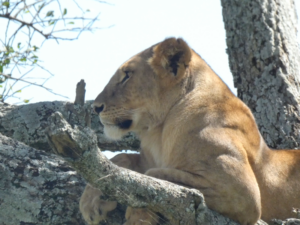
Young lioness napping in tree
A little farther on, Simon showed us a lioness resting up in a tree! Surprise! We watched for a while and saw her open her golden eyes. From that vantage point she could also check out the the surroundings. With the grass so high, she could see better from her perch. She had a bit of pink around her nose and spots on her belly so she was fairly young, around 4 years old. She alternated between gazing around and sleeping. We were lucky to see her. When we came by the tree on our way back she had vacated the premises.
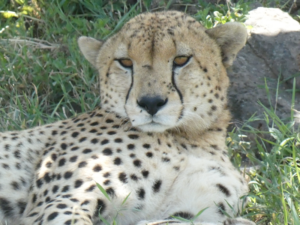
Miele, the Cheetah
After we left her resting, we found a cheetah resting in the shade on the ground. His name was Milele (Swahili for forever) and was once part of a pair. But his partner, Mbili, Swahili for two, left the conservancy and left him alone. Now he has to hunt somewhat smaller prey because he has to rely on his own strength and skill. You can differentiate cheetahs from leopards, by the Cheetah tear marks that extend down his face from his eyes and the white area on tip of his tail. This cheetah is about six years old.
Simon also told us that Topi are also known as “blue jeans and yellow socks” because of their distinctive coloration. They are glossier and darker variation of the hartebeest. small herds are common in the Masai Mara. They are among the faster antelopes in Africa. Males are often seen standing on hills as a show of dominance.
We also spotted some Olive baboon, the largest primate in Kenya. It can be recognized by its inverted u-shaped tail and dog-like head. The darker olive baboon is usually found in the west and the lankier yellow species in the east. The baboon has fascinating behaviors, lives in large, perpetually squabbling, and sex-obsessed matriarchal troops with dominance-seeking males moving between troops. Baboons usually steer clear of people but can become aggressive around campsites and lodges that they associate with food. In such cases, they should be treated with caution.
We were very lucky to catch sight of an Agamas Lizard sunning itself on a rock beside the trail. Agamas are medium to large lizards with bright plastic-looking scales – blue, purple, red, orange depending on the actual species. The flattened head is usually a different color from the torso. They have very long tails. Particularly spectacular are the male red-headed agamas that are often found basking in the sun on rocks.
Simon made his way to a spot overlooking the river and hippos for lunch. We had a small table and chairs and our picnic to enjoy. It was a great way to break up the day. Once our lunch was consumed, we headed back to the Karen Blixen conservancy welcome center.
On the way, we found the wildebeest herd that Linda Wilson of Untamed Expeditions found with Simon two weeks ago. We found the Mom with one horn/tusk and newborn baby, now two weeks old!
Once back at the reception center, we left Simon and headed back across the two rivers to Entim Safari Camp with Mikhail at the wheel of our LandCruiser.
Clouds were gathering and cooler damper air was coming in. We jumped into Mikhail’s Land Cruiser and started back to Entim Safari Camp. The clouds were dark grey and beginning to close in around us. About 1/3 of the way back, we were encased in cloud of dust – so we stopped and closed all the windows and lowered the pop up roof. Even so, my grey hair was now brown with dust. We passed others whose vehicles had no sides and they were frantically lowering canvas sides. We did get sprinkled on, lots of squishy mud, spinning tires, but, luckily, we made it back to Entim in time for a shower to eliminate the dust and grab dinner.



